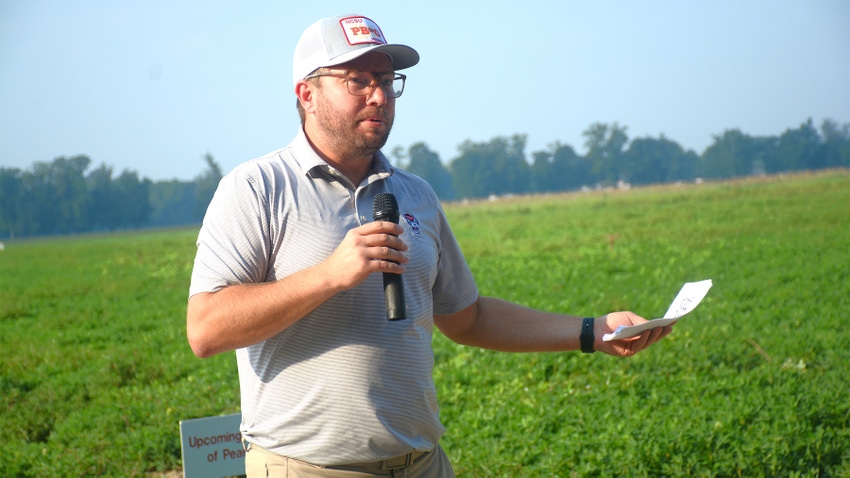
North Carolina State University Peanut Breeder Jeff Dunne remains hopeful that enough seed of NC 20, the new late season peanut cultivar released by his program, will be available to peanut farmers who want to give the variety a try next year.
Speaking at the 71st annual Peanut Field Day at the Peanut Belt Research Station in Lewiston-Woodville Sept. 7, Dunne announced that NC 20 will be commercially available for the first time in 2024. NC 21, another new peanut variety released by Dunne’s program, will be commercially available in 2025.

North Carolina State University Peanut Breeder Jeff Dunne says NC 20 performs very much like Bailey II, the most widely planted Virginia-type variety in the Carolinas and Virginia. (Photo by John Hart)
Late maturing varieties NC 20 and NC 21
Dunne says a big plus of both NC 20 and NC 21 is that they are later maturing varieties which will allow peanut farmers to harvest them later and extend their harvest window. NC 20 and NC 21 will mature anywhere from 7 to 10 days after such varieties as Bailey II.
Final selections for NC 20 and NC 21 were made in 2020 and 2021 respectively. Dunne notes that breeder seed was grown out in 2021 for NC 20 while breeder seed was grown out in 2022 for NC 21. The first year of foundation seed NC 20 was 2022 while the first year for foundation seed for NC 21 was this year.
Dunne said NC 20 performs very much like Bailey II, but with a little bit larger pod size. Like Bailey II, it offers a good disease-resistance package, especially for leaf spot and Tomato Spotted Wilt Virus. Dunne said NC-20 is very pure in terms of its high oleic content. Dunne emphasized that all the lines in his breeding program are now high-oleic due to demand from shellers for Virginia-type varieties that offer longer shelf life.
“NC 20 and NC 21 are pretty similar in the mindset of why we released them,” Dunne told field day attendees.
“When we do a lot of our leaf spot trialing, we also look at unsprayed yield. And the reason for that is to get an idea of what those margins are in terms of what are yield expectations would be under a heavy leaf spot pressure field without any application of fungicides, so one of the things we really liked about NC 20 and NC 21 is that they were really good at holding their pods under heavy leaf spot pressure, especially late in the season,” Dunne said.
“They are a little bit later maturing, so the other aspect that we really like is if you pair an NC 20 with a Bailey II in terms of pod size, you can get out of your fields at different times so you can leave NC 20 in the field a little later so you can stagger your harvest times. The same is true with NC 21. If you pair an NC 21 in terms of timing with Emery, you’ll be able to get your Emerys out of the field with the NC 21 following maybe a week or 10 days later. NC 20 was the first of our releases and therefore it’s the first to come to foundation seed, so that will be available as of next year. NC 21 will be the following year after that.”
Experimental lines N17045 and N17047
Dunne also highlighted two experimental lines, N17045 and N17047, that his program is evaluating for release. He said either N17045 or N17047 could be released as a commercial variety, possibly named NC 23, in a few years. He explains varieties his program releases are now named after the year final selections are made.
In the past, varieties released by the N.C. State peanut breeding program were named in honor of notable North Carolina peanut scientists. For example, today’s most popular Virginia-type peanut variety, Bailey II, and its predecessor, Bailey, were named in honor of the late Jack E. Bailey, formerly the peanut breeding program’s collaborating plant pathologist. The variety Emery was named in honor of the late D.A. Emery, N.C. State’s peanut breeder in the 1960s.
As for N17045 and N17047, Dunne said both lines are very similar in terms of pod size and seed size characteristics. He noted that in regional variety trials, both 17045 and 17047 showed good drought tolerance.
At the field day, Dunne explained that his program evaluates data on a significant number of traits to meet the demands of farmers, shellers, manufacturers, and consumers. He said this all proves to be resource intensive when it comes to how the N.C. Stat breeding program operates.
“We have to consider all of these individual groups when it comes to a variety that we are taking to market. When it comes to our breeding program, we set that up to reflect a lot of the consumer, sheller, and grower traits that are necessary for a variety to be successful,” he explained.
“When you think about peanut varieties, what are the first traits that come to mind? I think about yield. I think about disease resistance because when it comes to our growers, if it’s not yielding and it doesn’t have the traits in terms of the growers’ expectations, we don’t expect that to do very well as it’s making its way through the developmental process,” he said.
Read more about:
Variety SelectionAbout the Author(s)
You May Also Like






